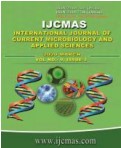


 National Academy of Agricultural Sciences (NAAS)
National Academy of Agricultural Sciences (NAAS)

|
PRINT ISSN : 2319-7692
Online ISSN : 2319-7706 Issues : 12 per year Publisher : Excellent Publishers Email : editorijcmas@gmail.com / submit@ijcmas.com Editor-in-chief: Dr.M.Prakash Index Copernicus ICV 2018: 95.39 NAAS RATING 2020: 5.38 |
Modern industrialization causes major environmental pollution and degradation. The Environmental changes results the genomic instability in human cells, bacterial cells and yeast cells. Due to high rate of genetic instability, mutation rate has become high and it induces the potential to adaptevolution for living cells. There are several physical and chemical mutagenic agents are available which can induce mutation in genetic materials. This paper exposed to isolate azo dye degradation bacteria from dye-contaminated soil and induction of mutation using X-rays, ultraviolet (UV) radiation and ethidium bromide to determine the highest dye-degrading mutant with higher dye degrading potentials, which could be employed in the bioremediation of industrial dyes. In this study, mutation was performed on the Bacillus species through physical (UV, X-rays) and chemical (ethidium bromide) mutagenic agents. The results revealed that, mutagenesis of bacteria by UV radiation increases the degradation ability of native bacterial isolates. It reflected that, gene specific mutation enhanced the degradation ability of bacteria and can be used for the development of novel remediation strategies. The growth and azo dye degradation capacity of the isolated strain was examined and compared with the mutated strain. The major purpose of this study was to demonstrate the effectiveness and the pathway used for dye degradation in the isolated strain and its mutant variant. The present study can be applicable to enhance the industrial dye degradation by using the mutated strain of bacillus.
 |
 |
 |
 |
 |